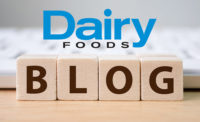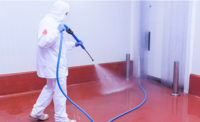
Food production environments for food and dairy operations offer a shell of protection from a range of contamination sources. Designating zoning to respective process areas in plant design is a method to control the environment in the food production areas. Through this zoning, plants can control traffic of people, materials, and air flow. Among other requirements, zoning dictates the fit and finish, level and method of cleaning, and required personal protection equipment (PPE) in the area.
Microbes, foreign matter, chemicals, or allergens can be abated by controlling the environment. Sensitive foods (i.e., easily spoiled) demand an elevated level of control to block microbes. Microbes can include pathogens or spoilage organisms inherent to the food growing to an unsafe level.
In restaurants and home kitchens, food is often prepared open to the room. Industrial scale food processing, in many cases, is a larger scale application of these practices resulting in processes open to the surrounding environment. As a result, the environment around food processing equipment becomes an extension of that equipment. A level of cleanliness to the space needs to be maintained to avoid contamination and preserve the food during the expected shelf-life and storage conditions.
Different industries have adapted different zone designations to separate the areas of cleanliness. For example, the pharmaceutical industry has multiple defined systems. For microorganism containment, different work zones use an alphanumeric label according to the Biosafety in Microbiological and Biomedical Laboratories (BMBL). For cleanliness levels, the International Organizations for Standards (ISO) have defined cleanliness set to numerical level.
Other groups such as the European Medicines Agency (EMA) use a similar letter designation system. The diverse range of food risks has left this an undeveloped section of the food industry. Within the food industry features in direct contact with products, like equipment, are well defined through criteria such as 3-A Sanitary Standards (available at www.3-a.org). Yet, defining the fit and finish of the full production environment is not as definitively spelled out. This causes many companies to develop their own definitions.
The different levels of zoning are layered like an onion, with the most susceptible area at the core. In a user requirement specification or construction package, a detailed definition of each care level should be given. This should include cleaning of equipment and room plans, examples of materials of construction, fit and finishes, personnel practices, Good Manufacturing Practices (GMP), and other related details.
The following naming example is used throughout the food industry, but no standard exists defining the levels. For this reason, it is important for each project to outline the expected definition of each level. Example levels in descending order are:
- High Care
- Medium Care
- Basic Care
- Non-GMP
High Care is the highest level of concern, which includes opening a product past its kill step (e.g., pasteurization). For ready-to-eat products, this is the last crucial step prior to sealing up the packaging for consumers. This area typically includes equipment with a detailed plan for frequent clean-in-place (CIP) and clean-out-of place (COP) of equipment and washdown environment. This can demand easily cleanable (i.e., 3-A SSI) equipment, smooth sealed floors, walls, and dropped ceiling. Practices of employees are also defined such as the use of hair and beard nets, gloves, captive shoe or booties, and special uniforms.
Medium Care includes open product upstream of the kill step (raw product). Cleaning and finishes are similar to high care but adjusted to the state and nature of the product. Part of this designation is to keep it physically separated from the product in high care to prevent contamination of the final product.
Low Care is a generally clean area with packaged and sealed products. Ingredients and final products rest in sealed containers. Ideally, products shouldn’t be exposed, but this could accidentally occur. This would not be washdown, but spills could be locally addressed. This level is used as a transition point where hairnets, boot covers/shoe changes, and other personnel transitions take place.
Non-GMP No production occurs in these areas. This includes other plant functions such as utilities, maintenance shop, offices, break rooms, and rest rooms. Though this isn’t a clean product space, it remains necessary to maintain cleanliness as a safe perimeter to the clean production space. General cleaning and pest control must be part of this space, as well as the space surrounding the building exterior.
After each separate space is identified, airflow through the plant must be mapped. The flow must be balanced so that the cleanest air is introduced with enough pressure to push air from the higher care areas towards lower care.
Personnel traffic needs to be addressed to limit movement between low-care and higher-care areas. To ensure proper protocols are followed, there should be transition stations in between the zones for changing of or additional protective garments, and hand washing. Minimize travel through the highest levels to essential staff and functions.
Zones may be further subdivided by processes that need to take place or to manage exposure of compounds. Therefore, cleaning practices must be identified and followed for specific areas such as whether wipe-down or full foaming stations are required. Walls and ceilings also should reflect this plan. For instance, an IMP flat ceiling or smooth drop-down may be needed for the space to easily clean overhead.
If the product or cleaning chemicals are acidic or basic, or if there are elevated temperatures. this can lead to different surface materials and sealing practices. Especially in higher care areas, the same considerations must be given to room as within equipment, avoid pockets cracks and crevices. If product or cleaners are high-temperature or corrosive, an acid brick or urethane cement finish may be required over a more basic hardened sealer used in other areas.
Overall, the zoning method of plant design offers a layered protection shell to surround product by segregating areas and controlling all flows, and assigning proper fit and finishes. Correct application gives a supportive protection to sensitive foods.




